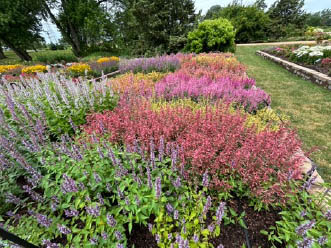Chicagoland and Environs
Contact
University of Arkansas System Division of Agriculture
Cooperative Extension Service
2301 S. University Ave.
Little Rock, AR 72204

Chicagoland and Environs
I’m not lost, just meandering. For the last three years, I’ve made it to the Moccasin Creek Music Festival in Effingham, Illinois. Being so close to the big city of Chicago, I thought I would take advantage of the opportunity to see some of the things I’ve long wanted to see.
Driving out of St. Louis, it wasn’t long before I started seeing patches of dead trees along the roadside. The trees were ash - mostly green ash as near as I could tell - that had fallen victim to the emerald ash borer. This introduced beetle came from China (probably in wooden crates about 2002) and was first noticed in Michigan. Aggressive measures, primarily related to removing a large swath of ash trees around all infestation hot spots, seemed draconian at the time, but they weren’t enough. Losing ash trees is a big deal in the more northern states where woodlands can contain 15-20 percent ash in their wetter regions.
The emerald ash borer has now been reported in more than 30 states, including southern Arkansas. Because of this pest, ashes are no longer being grown in the nursery trade. Just as with Dutch elm disease, not every ash tree dies. It is believed that the escapes may produce higher levels of tannins in the sap which ward off the insect larvae before they become established in the cambial region of the tree. Ash will not likely disappear from North America, but they may never recover their once prominent place in the woodlands.
Coming into Chicago I was glad to drive part of the way on old Route 66, the roadway that stretches from Chicago to Santa Monica and was famously dubbed by John Steinbeck “the Mother Road” in his 1939 Pulitzer Prize-winning book, The Grapes of Wrath. Though officially delisted as a Federal highway in the 1980s, this and several other venerable old roads will be celebrating a century of service over the next two or three years. As I head west to Idaho later this week, I will follow the Yellowstone Road (US 212) that was started in 1926 and stretches from Minneapolis to the north gate of Yellowstone National Park. These old roads are time capsules of history, often in a slow, seedy kind of way.
In West Chicago, I had the opportunity to visit the Ball Horticulture trial gardens. The name Ball has been synonymous with flower seed production for over a century, but it is unfamiliar to most home gardeners. This family-owned multinational corporation focuses on meeting the needs of commercial greenhouse growers by providing vigor-tested hybrid seeds of all major floricultural crops and cuttings of an ever-expanding list of pot plants and garden perennials. Some seed is produced in Illinois but most is grown in California, Costa Rica, Africa, Asia and Europe.
The trial garden is beautifully and imaginatively laid out to showcase the merits of the plants they grow and demonstrate how they can be used in a variety of garden settings. Some are in the ground in side-by-side comparison trials, some in large patio containers and others in hanging baskets.
The work Ball and four or five other large horticultural firms do in stocking the greenhouse industry is nothing short of amazing. Industry dominance, however, comes at a cost. Drive down the streets of San Francisco, Salt Lake, or Atlanta, and you see essentially the same plants being grown. Sameness is not bad, it’s just not as interesting as it could be.
While on my way to see something else, I stumbled across Lurie Garden, a 2.5-acre gem at the south end of downtown Chicago’s Millennium Park. This was a completely different kind of garden experience. It is a lush patch of prairie with blooms everywhere. It supplies the kind of natural experience many of us envision a native plant garden can provide. Like the mid-19th century Hudson River School of painters, it portrayed nature as being more beautiful and orderly than it really is.
It turns out that this prairie garden is a rooftop garden atop the subterranean parking garage, which is over even more deeply buried train tracks. There are two sections in the garden; part in shade and part in full sun. The sunny prairie section uses 250 herbaceous species and grasses, about 60 percent of which are native to Illinois. Now in its 20th year, the $13 million garden delivers on the promise of native gardens by attracting more than 40 species of native birds and a bunch of butterflies to this mid-city garden. The garden is named for Ann Lurie, who gave $10 million to establish an endowment for perpetual maintenance of the space.
Giving money for perpetual maintenance is a hard sell. But, as any who have gardened know, it is maintenance that makes a garden space work. The best garden design quickly falls apart unless close attention is paid to maintenance. One of the misconceptions proponents of natural landscaping have is that they require little maintenance — but to make and keep these spaces beautiful and worthy of being called a garden takes a lot of work.
